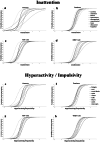Differential utility of teacher and parent-teacher combined information in the assessment of Attention Deficit/Hyperactivity Disorder symptoms
- PMID: 32246275
- PMCID: PMC7864845
- DOI: 10.1007/s00787-020-01509-4
Differential utility of teacher and parent-teacher combined information in the assessment of Attention Deficit/Hyperactivity Disorder symptoms
Abstract
Background: Consistent research findings indicate that parents and teachers observe genuinely different Attention Deficit/Hyperactivity Disorder (ADHD) behaviours in their respective settings.
Objective: To evaluate the utility of information provided by teacher informant assessments (INFAs) of ADHD symptoms, and the implications of aggregation algorithms in combing parents' information, i.e. using 'or-rule' (endorsement by either one informant) versus 'and-rule' (endorsement by both informants).
Method: Teacher ratings on Conners scales and clinical data from parental accounts on 1383 probands and their siblings from the IMAGE study were analysed. The psychometric properties of teacher and combined ratings using the item response theory model (IRT) are presented. Kappa coefficients, intraclass correlations and linear regression were employed.
Results: First, teacher endorsement of symptoms is located in a narrow part of the trait continuum close to the average levels. Symptoms exhibit comparable perception in the measurement of the trait(s) with similar discrimination ability and information (reliability). Second, the IRT properties of the 'or-rule' ratings are predominantly influenced by parent-INFAs; and the 'and-rule' ratings predominantly by teacher-INFAs ratings. Third, parent-teacher INFAs agreement was low, both for individual items (κ = 0.01-0.15) and for dimensional scores (r = 0.12-0.16). The 'or-rule' captured milder expressions of ADHD symptoms, whereas the 'and-rule' indexed greater severity of ADHD.
Conclusions: Parent and teacher-INFAs provide different kinds of information, while both are useful. Teacher-INFA and the 'and-rule' provide a more accurate index of severity than an additive symptom count. Parent-INFA and the 'or-rule' are more sensitive for detecting cases with milder ADHD.
Keywords: ADHD DSM-IV criteria; Caseness; Diagnostic overshadowing; IRT; Parent/teacher.
Conflict of interest statement
ESB: Speaker fees, consultancy, research funding and conference support from Shire Pharma and Janssen Cilag. Consultancy from Neurotech Solns, Aarhus University, Copenhagen University and Berhanderling, Skolerne, Copenhagen, and KU Leuven. Book royalties from OUP and Jessica Kinglsey. Royalties from the New Forest Parenting Package. TB served in an advisory or consultancy role for Actelion, Hexal Pharma, Lilly, Lundbeck, Medice, Novartis, Shire, received conference support or speaker’s fee by Lilly, Medice, Novartis and Shire, has been involved in clinical trials conducted by Shire & Viforpharma and received royalties from Hogrefe, Kohlhammer, CIP Medien, Oxford University Press.
Figures
Similar articles
-
Measurement invariance of Attention Deficit/Hyperactivity Disorder symptom criteria as rated by parents and teachers in children and adolescents: A systematic review.PLoS One. 2024 Feb 23;19(2):e0293677. doi: 10.1371/journal.pone.0293677. eCollection 2024. PLoS One. 2024. PMID: 38394179 Free PMC article.
-
Is the endorsement of the Attention Deficit Hyperactivity Disorder symptom criteria ratings influenced by informant assessment, gender, age, and co-occurring disorders? A measurement invariance study.Int J Methods Psychiatr Res. 2019 Dec;28(4):e1794. doi: 10.1002/mpr.1794. Epub 2019 Jul 16. Int J Methods Psychiatr Res. 2019. PMID: 31310449 Free PMC article.
-
Item Response Theory Analysis of ADHD Symptoms in Children With and Without ADHD.Assessment. 2016 Dec;23(6):655-671. doi: 10.1177/1073191115591595. Epub 2015 Jul 1. Assessment. 2016. PMID: 26139830 Free PMC article.
-
Parent and teacher rating scales in the evaluation of attention-deficit hyperactivity disorder: contribution to diagnosis and differential diagnosis in clinically referred children.J Dev Behav Pediatr. 2006 Jun;27(3):209-18. doi: 10.1097/00004703-200606000-00006. J Dev Behav Pediatr. 2006. PMID: 16775518
-
Parent-based diagnosis of ADHD is as accurate as a teacher-based diagnosis of ADHD.Postgrad Med. 2017 Apr;129(3):375-381. doi: 10.1080/00325481.2017.1288064. Epub 2017 Mar 8. Postgrad Med. 2017. PMID: 28271921 Free PMC article. Review.
Cited by
-
Measurement invariance of Attention Deficit/Hyperactivity Disorder symptom criteria as rated by parents and teachers in children and adolescents: A systematic review.PLoS One. 2024 Feb 23;19(2):e0293677. doi: 10.1371/journal.pone.0293677. eCollection 2024. PLoS One. 2024. PMID: 38394179 Free PMC article.
-
Does interpersonal self-support matter for freshman nursing students' professional identity? Evidence from mainland China.Front Psychol. 2023 May 23;14:1123625. doi: 10.3389/fpsyg.2023.1123625. eCollection 2023. Front Psychol. 2023. PMID: 37287771 Free PMC article.
-
Attention deficit hyperactivity disorder: A pilot study for symptom assessment and diagnosis in children in Chile.Front Psychol. 2022 Aug 4;13:946273. doi: 10.3389/fpsyg.2022.946273. eCollection 2022. Front Psychol. 2022. PMID: 35992438 Free PMC article.
-
Network analysis of 18 attention-deficit/hyperactivity disorder symptoms suggests the importance of "Distracted" and "Fidget" as central symptoms: Invariance across age, gender, and subtype presentations.Front Psychiatry. 2022 Oct 21;13:974283. doi: 10.3389/fpsyt.2022.974283. eCollection 2022. Front Psychiatry. 2022. PMID: 36339870 Free PMC article.
-
Longitudinal relations of prematurity and fetal growth restrictions with hyperactivity/inattention and aggression/delinquency.Pediatr Res. 2024 Dec;96(7):1843-1852. doi: 10.1038/s41390-024-03297-y. Epub 2024 Jun 19. Pediatr Res. 2024. PMID: 38898109 Free PMC article.
References
-
- National Institute of Health and Care Excellence (NICE). (2018) Attention Deficit Hyperactivity Disorder: diagnosis and management. NICE guideline. www.nice.org.uk/guidance/ng87 - PubMed
-
- Tripp G, Schaughency EA, Clarke B. Parent and teacher rating scales in the evaluation of attention-deficit hyperactivity disorder: contribution to diagnosis and differential diagnosis in clinically referred children. J Dev Behav Pediatr. 2006;27(3):209–218. doi: 10.1097/00004703-200606000-00006. - DOI - PubMed
MeSH terms
Grants and funding
LinkOut - more resources
Full Text Sources
Medical




